After five years of concentrating on one Madeira grape at a time: Terrantez, Verdelho, Bual, Malvasia and Sercial respectively, it was time for a change of pace. To put it in perspective, all of the nearly 100 bottles we’ve tasted under the same roof in NYC; have combined for a staggering total of circa 17,000 years of age. Our score of Madeira loyalists have remained unjaded by such finery, open to new experiences, Madeiras and friendships that have developed within the group.

Article and photos by Roy Hersh © December 2017
As we moved forward to replace Del Posto, we chose a new venue, Dirty French, which is located in the Ludlow Hotel on the Lower East Side of Manhattan. All participants were looking forward to the new face and food too. This year, we have chosen to pair off the last two noble grapes from Madeira, as our grape exploration theme comes to an end, and rightly so, with: Dueling Bastardo vs. Moscatel.
It is fitting, as both of these old school cultivars are all but extinct on the island, having nearly been wiped off the face of earth by subsequent waves of Oidium (1851) and Phylloxera (1872) respectively. While a few new vines of each grape have been propagated in recent years, their commercial viability remains in doubt. However there are signs of hope and the innovative winemaker at Vinhos Barbeito, Ricardo Diogo Freitas has been experimenting with new plantings of this cultivar and also has produced a couple of new bottlings of Bastardo.
For the tasting on Saturday, April 22nd 2017, we have selected some sensational bottles of Bastardo to compare within a trio of flights from the excellent vintages of that grape from 1927, 1875 and 1870; in addition to a troika of older bottlings in the fourth and final flight featuring this grape. The lines of battle for this duel have been drawn, as we contrast eight outstanding examples of the Moscatel grape divided into two flights of four bottles each. The first highlights a trio of 1900s and one 1890, followed by a foursome including 1875 & 1870 (juxtaposed to the same Bastardo years) and a singular 1856.
Bastardo does still exist on the island in very limited quantites. In fact, Ricardo Freitas the aforementioned winemaker/master blender at Barbeito, (an honored guest at all of our NY Madeira tastings) produces limited production runs of Bastardo nowadays. A decade ago Ricardo made a few hundred liters in 2007 and the following year, next to nothing was produced. I believe he sources his grapes from São Jorge, along the north coast. It has always been a challenging red grape due to its susceptibility to oidium from the rain and humidity of Madeira, plus it has difficulty in adapting to its surrounds. Naysayers point to the pinkish, often salmon colored wine it produces, overtly sweet and occasionally lacking the requisite balancing acidity.
Bastardo was used in Port production for many years, but today, it has few proponents in the Douro. It does proliferate elsewhere in Portuguese wine regions, I have had some excellent recent examples of it when visiting Setubal; both Bastardo and Bastardinho from this spectacular peninsula.
As for Moscatel, (Muscat Alexandria or Muscat Alejandria in Portuguese), the days of its use for Madeira production are in the rear view mirror, with very few exceptions. One exception lies in the canteiro room at Henriques & Henriques, where they have a single cask containing 520 liters of 1978 Moscatel patiently aging in casks in their famed Canteiro rooms. The IVBAM which keeps track of all production and sales, including by grape, has noted thirteen and a half liters of Moscatel that were sold commercially in 2015. Sadly, the Madeirense grape farmers earn more cash by selling their Moscatel as table grapes nowadays.
Having the once-in-a-lifetime opportunity to have eight consecutive Moscatels from Madeira is something few have ever been privy to. In fact, the last time I had more than three in a row was in 2005. I flew from Seattle to Pittsburgh in order to participate in my friend Jim Israel’s outstanding Malvazia & Moscatel weekend event, also attended by Mannie Berk and Dr. Bob Maliner at the Nemacolin Woodland’s Resort. The four Moscatels we had during that Madeira party are all going to be included in our lineup today and it will be fun to see how they have evolved over the past dozen years.
Since this is our sixth and last grape-focused Madeira tasting event, we have already been considering new variations on the theme and come next year, we will introduce something radically different to keep it fresh in addition to moving cross country in 2018, to San Francisco. The twenty wines before us today should make for a fascinating duel, delineating the unique nuances of both venerable grapes. Mannie and I would like to thank all of our guests for their generosity of spirit and traveling from throughout the USA and those who have come from thousands of miles across the pond to take part in this day into night Madeira celebration; the island responsible for producing the world’s longest lived wines!
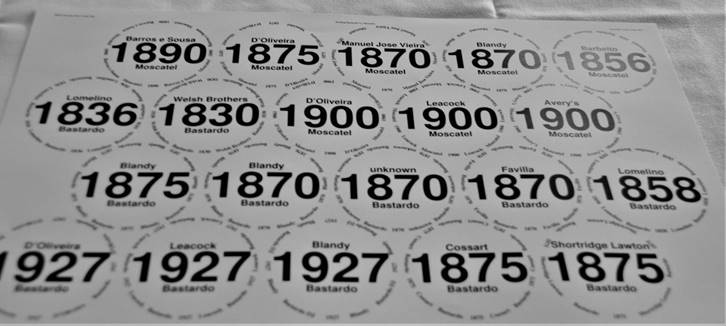
From Mannie Berk, owner of The Rare Wine Co. (with permission) and a co-organizer of this event; some historical perspective: The vanishing of Terrantez after Phylloxera has long been one of the great heartbreaks for Madeira lovers. Today, pre-Phylloxera examples are painfully rare, and although a few growers have replanted it in recent decades, Terrantez of any age remains scarce.
Yet, another famous Madeira grape has proven even more elusive: Bastardo. Many longtime Madeira drinkers have never seen—much less drunk—a bottle, and its history is shrouded in mystery. Owing to its miniscule yields and vulnerability to insects, little was ever planted, and even less was ever bottled on its own.
While no one knows exactly when Bastardo arrived in Madeira, some viticultural scholars believe that it came from Greece with Malvasia as early as the 1400s. For further evidence of ancient
residence, others point to Shakespeare’s “score a pint of bastard in the Half-moon” in King Henry IV. Like Terrantez, Bastardo essentially vanished after Phylloxera.
In the decades leading up to Phylloxera, each year saw a Bastardo crop, but yields were usually too small to bottle it on its own. Shippers, instead, would use it to beef up their most prestigious blends, or—as Cossart-Gordon did with its 1844 harvest—to create a small solera. After Phylloxera, few growers replanted the grape, making it even rarer. During the entire first half of the 20th century, only one vintage Bastardo was made, in 1927.
In fact, until World War II, we know of vintage Bastardos being made only in the following years: 1830, 1836, 1858, 1870, 1875, 1876 and 1927.
Adapted from The Rare Wine Co. Newsletter, October 3, 2006. Copyright, The Rare Wine Co.
Below you will find my tasting notes (RH) and some further perspective by Mannie Berk (MB).
(MB) To date, 1927 Bastardo has been commercialized under three labels: Adegas do Torreão, Leacock and D’Oliveira.* But what is the origin of each of these wines? For starters, we know that D’Oliveira and Torreão share a common source. But what is it? Is it Torreão itself? And if so, how did Torreão acquire it? The secret could possibly lie in a couple of barrels of 1927 Bastardo at the Henriques & Henriques lodge in Cama de Lobos, that have never been offered for sale and few mortals have ever tasted. (I requested a sample from H & H for this tasting, but it was not to be.) Henriques’ Bastardo plantings in Câmara do Lobos are legendary: a Henriques wine was the source of the famous 1870 Bastardos of Blandy’s and Avery’s. We may never know if this is where the Torreão wine began its life, or if it came from other vineyards on the island.
(RH) Just a quick comment on Bastardo, based on IVBAM regulations, Bastardo, unlike the other grapes from Madeira can be used at any level of sweetness!
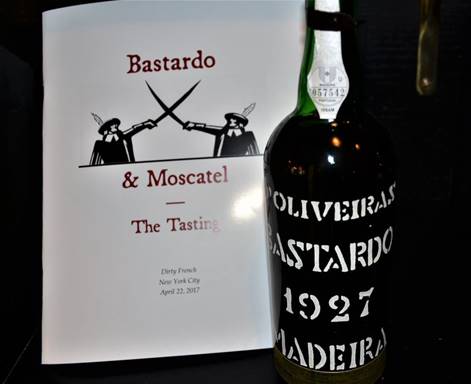
(RH) 1927 D’Oliveiras Bastardo Frasqueira Madeira – Bottled in 2014. One of only two red grapes, (the other is Tinta Negra) used for Madeira production. Yes, all the rest are white grapes! This bottling is from Adegas de Torreão, and very little was ever bottled due to extremely low yields and the amount vinified was simply too small to bottle on its own. When the inventory of Torreão was sold to D’Oliveiras in 2002, this was one of the gems in their cellar. It was bottled in 20006 from one original cask. Henriques & Henriques also own a few barrels of their own 1927 Bastardo, (and possibly Leacock’s too). Medium amber/gold optic with tawny meniscus. Delightful scents of Asian tea leaf, mint, menthol, orange marmalade and mango. This 1927 is light to medium weight, spicy, off-dry and lacks the typical D’Oliveiras house style, as this was likely purchased through a paradista (supplier, stockholder and not a shipper).
Generous flavors of marzipan, lime zest, loads of acidity, round and balanced, with a delicate long drying finish. 92 points - 4/22/17
(MB) 1927 D’Oliveiras - Adegas do Torreão, an important partidista located near the historic Hinton Torreão sugar works in Funchal, was founded in 1949 by Vasco Loja, who—during the difficult years of the 1960s and 1970s—built Torreão into one of the island’s most powerful wine companies, supplying large amounts of wine to the island’s remaining shippers. After Loja’s death, D’Oliveira purchased the company’s lodge building in 2002, and in so doing acquired a number of wines still in barrel, including the 1927 Bastardo.
(RH) 1927 Leacock’s Bastardo Frasqueira Madeira – Bottled in 2014. I’ve had this wine a few times and coincidentally it was the first Madeira I ever purchased, at $135 back in 1993; or so say my notes when it was consumed in 2003. Very dark cola color with golden edge. There was a lightly medicinal note with high toned gentle VA, a floral fragrance, pine resin, potpourri and mahogany. Its sweet entry and moderate level of acidity gives an even older impression. It remains sweet and with layered waves in the mid-palate, Earthy sweet toffee finish of medium length. Rich and generous, it tastes like it is artificially sweetened, possibly an additive? It remained in bottle the longest of all three; more than likely this is originally from Henriques & Henriques. 92 points - 4/22/17
(MB) 1927 Leacock Bastardo - This bottling appears to have been released in the 1970s and/or 1980s. Purchased at a Spectrum auction 2011. Was its source Adegas do Torreão?
(RH) 1927 Blandy’s Bastardo Frasqueira Madeira – Dark extracted coffee color with straw- yellow edge. Nose of iodine, root beer, and the richest of the 1927’s with a full-bodied frame, great harmony, soft texture and a long impressive finish with mild drying tannins. Great depth and complexity with finely-tuned acidity at the exact level of precision that I like. This Bastardo spent time in demijohn. 94 points - 4/22/17
(MB) 1927 Blandy Bastardo Demijohn Selection - Purchased at Christie’s, London, December, 2013. Six bottles were sold in single-bottle lots. A private, non-commercial bottling, from demijohn in 2013, with a red embossed wax capsule.
(RH) 1875 Cossart Bastardo Frasqueira Madeira – My first time trying this bottling again since 2007. Medium dark mahogany hue and darkest of the 2nd flight with a golden-green meniscus. Effusive nose of exotic tropical fruits, saline, sandalwood, menthol, orange and exotic Indian spice. It is the driest of the first four Bastardos we’ve tasted with very low RS, but powerful acidity. In possession of a long and dry finish this is more reminiscent of a very well made Sercial, with a hint of tobacco and cereal grains. It is a nice Cossart but somewhat four square, with slight bitterness on the finish. If there was a drop more sweetness and depth in the center, this would have been a stunning Bastardo. I kept coming back to this glass and it did improve over the next hour, offering nectarine and lime flavors and a hint of mint, while focusing on the flight of 1875’s. 93 points - 4/22/17
(MB) 1875 Cossart Gordon Bastardo. Two-part stenciled bottle (with heavy paint) that reads “Bastardo 1875 Cossart Gordon & Co Madeira.” Remains of wax capsule with no embossing noticeable. This is the first of three 1875 Bastardos we’re tasting that originated with the Madeira Wine Association, and possibly the earliest bottling of the three.
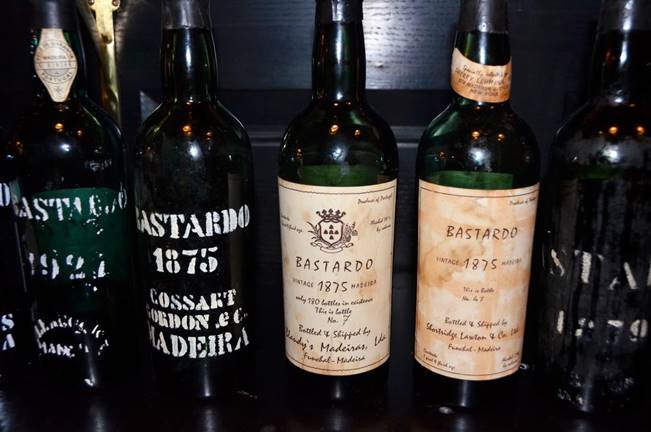
(RH) 1875 Shortridge Lawton Bastardo Frasqueira Madeira – Lighter caramel color. Austere nose that no amount of coaxing was able to improve, but there was quite a bit of overt high-toned VA. Tropical sweetness of over-ripe nectarine a floral fragrance and touch of toffee. Sweet entry that grew drier and the interplay of sweet and dry created a fine interplay, as it remained in mouth. Flavors ranged from plum, prune, grapefruit and caramel to a dry walnut pith note. The acidity was precise and crisp, the medium-long finish was concentrated and with intensity and complex flavors of roasted chestnut. A very well-made Bastardo, likely the same as the Cossart. 94 points - 4/22/17
(MB) 1875 Shortridge-Lawton Bastardo - Selected by the Madeira Wine Association for Sherry- Lehman, New York. Sherry-Lehman and its predecessor Sherry Wines & Spirits sold wines from the Madeira Wine Association for nearly two decades, initially offering Blandy’s-labelled wines exclusively. But in the 1970s, it began selling a few old vintages with another MWA brand, Shortridge-Lawton. The 1875 Shortridge-Lawton Bastardo bears a back label signed by Jeremy Zino, and is bottle no. 47 of 120. This wine was sold by Sherry-Lehman in 1970 for $24.50 a bottle. This particular bottle was purchased last year at an HDH auction, having originally come from the cellar of the American collector Lenoir Josey, a favorite source of Madeira for Christies auctions. As for Shortridge-Lawton, this was once an important shipper, founded in 1757.
According to Noël Cossart, John Shortridge was the first president of the Associacão Comercial (Chamber of Commerce) of Madeira from 1835-1839 and was responsible for protecting the interests of shippers in respect of the Portuguese government.
(RH) 1875 Blandy’s Bastardo Frasqueira Madeira – Almost as dark as the Cossart version. This 1875 Blandy’s delivers an interesting nose with a sweet cherrywood scent, and also includes a jammy fig note, tar, bitter orange essence and mahogany. But initially there was some serious bottle stink that did not blow off with an extended decant. Meio-doce, complex in the mid-section, with mild tannins present, but it all led to a surprisingly clipped finish with a slight but undeniable bitterness on the ending. 88 points - 4/22/17
(MB) 1875 Blandy Bastardo - Bearing Blandy’s paper front and back labels, this is a different design from those Blandy’s Madeiras featured in the Sherry-Lehman ads. Also, this wine does not appear to have been offered by Sherry-Lehman, nor is it signed not by John Reeder Blandy or Horace Zino, as the Sherry-Lehman Blandy’s wines were. It was signed by Ferdinando de Bianchi, who became managing director of the Madeira Wine Association in 1969 on the retirement of Zino. He was a direct descendent not only of Carlo de Bianchi, but also Tarquinio Lomelino and Robert Leal. According to the back label, "This wine was acquired by us some years ago and we endorse it is a fine rare wine of exceptional quality." This is bottle no. 7 of 180. Purchased at a Spectrum auction in 2011.
(MB) 1870 Bastardo - In 1984, when Noël Cossart wrote that it came from Padre Henriques via Stephen Gaselee, 1870 Avery’s Bastardo became iconic. It went from costing less than $10 a bottle in the 1960s (ex-Avery’s) to selling for over $550 a bottle at a Christie’s London sale in June, 1990, a time when it was rare for even the rarest Madeiras to cross the $200 threshold. But what about the other 1870 Bastardos? The Favila Bastardo in this flight seems clearly to come from a different source: the Favila family in São Martinho. But what about Blandy’s 1870? By attributing the same Henriques/Gaselee provenance in his book, Alex Liddell seems to suggest that it is the same wine as the Avery’s bottling. * Perhaps the unknown 1870 Bastardo we’re tasting today shares that lineage as well. *I recently asked Alex if he remembers on what basis he assumed that the Blandy’s 1870 and Avery’s 1870 had a common source. Unfortunately he no longer has his notes and doesn’t recall.
(RH) 1870 Blandy’s Bastardo Frasqueira Madeira – Medium dark caramel color with golden edge. Reticent aromas of toffee, tangerine, fig and loads of pure cinnamon raisin scents. An ethereal and intriguing profile. Light-medium weight, coarse texture and warm with a dose of volatile acidity that provided sophistication in the same way that petrol does for aged German Riesling. Modest juicy-citrusy acidity, medium-sweet up front and a bitter finish of medium length. Vinous, feminine yet very well-balanced this 1870 Blandy’s reminded me of a medium sweet Verdelho. 93 points - 4/22/17
(MB) 1870 Blandy Bastardo - Indistinct stenciling that reads “Bastardo 1870 Blandys Madeira.” The embossed black wax capsule reads “Blandy Madeira.” According to Alex Liddell’s book, this comes from the same source as Avery’s: Padre Henriques via Stephen Gaselee (per Noël Cossart). See page 10 .
(RH) 1870 Unknown Bastardo Frasqueira Madeira – Medium dark optic. The fragrances here were singular compared to all previous Bastardo bottlings we had encountered, with sophisticated notes of iodine, purity of sugar cane, an earthy essence along with wasabi mustard, and finishing off with a sweet honey… almost botrytised note. Medium in weight, sweet and rich, void of any real depth in its core or finish. Unremarkable palate presence with a short to medium finish. My least favorite Bastardo to this point in the tasting. Glad it was “unknown”. 84 points - 4/22/17
(MB) 1870 Unknown Bastardo - Very similar stenciling to the 1870 Blandy’s. The main differences are that “1870” is smaller in size, and there is no evidence of a shipper’s name ever having been stenciled on the bottle. Old black wax capsule with no discernable embossing. While possibly the same wine as the 1870 Blandy’s, we can at least be confident that it’s a Madeira Wine Association bottling.
(RH) 1870 Favilla Bastardo Frasqueira Madeira – to close out the flight from this vintage, the Favilla presented a medium dark orange amber hue with ruby glints at the core and a golden-green edge. Funk on the nose, iodine plus VA, along with a smoky scent and swirling golden raisin scent. Fine crisp acidity, sweet but simple throughout and a dry and bitter finish. It was almost unpleasant but the overall balance and nice aromatic profile kept this from being a total failure. The VA in this case was a distraction. 87 points - 4/22/17
(MB) 1870 Favila Bastardo - According to Ricardo, this bottle belonged to Manuel José Vieira, the owner of the Ribeiro Real property in Câmara de Lobos as well as the producer of the 1870 Moscatel we’ll taste later today. Vieira also had substantial vineyards in São Martinho, and Ricardo believes this wine came from there. The bottle itself was in the Favila Vieira family cellar at Rua da Carreira for more than 40 years and was recorked in 1998.
(RH) 1858 Lomelino Bastardo Frasqueira Madeira – Medium dark maple syrup tone with a golden edge. A fine bouquet of stewed prune, dried date, earthy mushrooms and burnt matchstick. Concentrated and smooth, intensely sweet with a honeyed pecan flavor along with figs, dried apricot, toffee and a slight sense of underwhelming acidity level in a light-medium frame. This 1858 was soft and elegant texturally, yet almost cloying and biting due to the bitter flavor towards the medium length finish. The aromatics and initial flavors were very good and it could have been a contender, but not today. 90 points - 4/22/17
(MB) 1858 Lomelino Bastardo (Re-bottled 1900 ). Yellow lead capsule, Lomelino paper label with re-bottling date, “Leacock Madeira” painted on bottom front of bottle. Bears the initials “C. de B.” for Carlo de Bianchi. Purchased at the Leacock Family Sale* at Christies, London, December, 2008. This vintage was not catalogued and so totally unexpected: several bottles mysteriously appeared in the four lots of 1836 Lomelino Bastardo lots (see next wine). Prior to this sale, this wine was unknown, and, like the 1836, it probably came into the Leacocks’ possession when Lomelino joined the Madeira Wine Association in the 1930s. The Lomelino firm sprang from an earlier company—that of Robert Leal, which began trading in 1820. Leal was among the most important Madeira shippers of his day, and the wines of “Bobby Leal” were found on the finest American wine lists of the mid-1800s. Born in 1795, Leal died in 1873 without heirs. And so he left his business to his protegé, Tarquinio Torquato da Câmara Lomelino (1818-1888). On Tarquinio’s death, the business passed to Carlo de Bianchi, who was related by marriage. Carlo was also the great-grandfather of Noël Cossart.
(RH) 1836 Lomelino Bastardo Frasqueira Madeira – Medium dark with golden rim. The last time I had this Bastardo was in the beginning of the summer of 2009. This was in the Leacock family’s possession for 80 years and is supposedly the oldest known bottling of Bastardo ever produced. A swirling perfume of sultana and teriyaki, prune and pecan is unusual and exotic. Medium body weight, suave and stylish, with an uber-smooth mouthfeel. Well-balanced with prominent focused acidity. Caramel, peach and medium-sweet tropical fruits, almost in the Boal range, with a slight bitter note on the medium-long finish. One of the few Bastardos that I can say was rather inspiring so far. 92 points - 4/22/17
(MB) *This sale represented virtually all the surviving Madeiras the Leacock family accumulated as a member of the Madeira Wine Association between 1913 and 1989. Many of the wines sold were made by the Leacocks. But others, like this Lomelino Bastardo, were made by other MWA members prior to joining the association. In terms of the importance and rarity of the Madeiras offered, it is highly unlikely that we will ever see a sale like this again. 1836 Lomelino Bastardo (Re-bottled 1926). Yellow lead capsule, Lomelino paper label with re-bottling date. “Leacock Madeira” painted on bottom front of bottle. The label is very similar to the 1858, except for the absence of “C. de B.” See note for 1858 above.
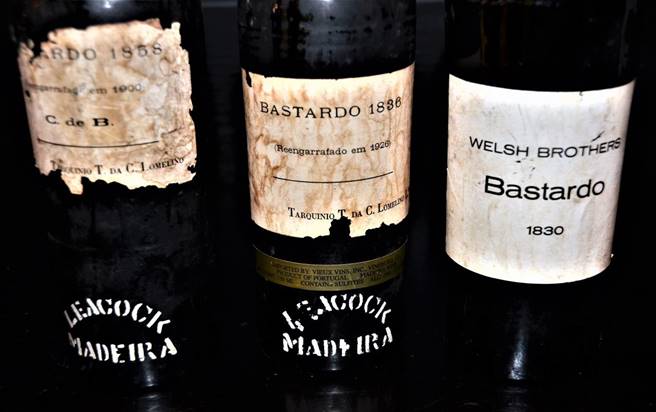
(RH) 1830 Welsh Brothers Bastardo Frasqueira Madeira – An earthy essence of saline, smoke, kalamata, and high toned VA. Ample acidity and a slightly bitter walnut pith flavor noticeable in the middle and ending. Much drier than the 1836 Bastardo, and in this case, not my style. The fruit of this Madeira is beginning to head over the hill in my opinion. The ending fell of the cliff rather quickly too. Soft and velvety, the mouth feel was one of the best parts about this 1830 86 points - 4/22/17
(MB) 1830 Welsh Bros. Bastardo - A simple black and white label of the Madeira Wine Association style (which was previously associated, erroneously, with Michael Grabham). Purchased at a Christies sale, December 2015. A three-part molded bottle, with an embossed brown wax capsule. Welsh Brothers was founded at the end of the 18th century by Philadelphia’s George Day Welsh. One of several American firms who’d set up shop on the island, Welsh Bros. sought membership in the British Fractory, ultimately to be turned away by the members on December 9, 1809: “Resolved unanimously that no American subject can ever become a Member of this Factory.” According to Henry Vizitelly, by 1849, Welsh Brothers was the largest shipper by volume by concentrating on “cheap light Madeiras.” But by 1870s, again according to Vizitelly, the firm “confined itself almost exclusively to shipping the more costly growths, sending the latter largely in bottle to the United States and other markets.” Welsh Brothers remained an independent house until the 20th century, when became a founding member of the Madeira Wine Association (MWA).
(MB) 1900 Moscatel - Until the 1970s, Pereira D’Oliveira functioned primarily as a partadista, supplying shippers on the island. In that role, in 1985, D’Oliveira sold 660 liters of 1900 Moscatel to the Madeira Wine Company. That’s a possible source for the Avery’s and Leacock bottlings.
(RH) 1900 D’Oliveiras Moscatel Frasqueira Madeira – Dark reddish-brown and golden edge. Intense aromatics with mahogany, peach, sweated onions, toffee, and raisins. This really reminded me of Moscatel de Setubal. Medium-bodied and rich, with far more complexity and tensity, and a mélange of molasses, tropical fruits, crème brûlée and espresso bean flavors.
Finely focused thanks to the poised acidity and it’s definitely in synch with some of the sweetness here, the finish possesses one of the cleanest and longest finishes of the day with torrefacted flavors on the long and lingering finish. 93 points - 4/22/17
(MB) 1900 D'Oliveira Moscatel - Probably bottled in the 1970s or 1980s by Pereira D’Oliveira and recorked within the past decade. Acquired from the family.
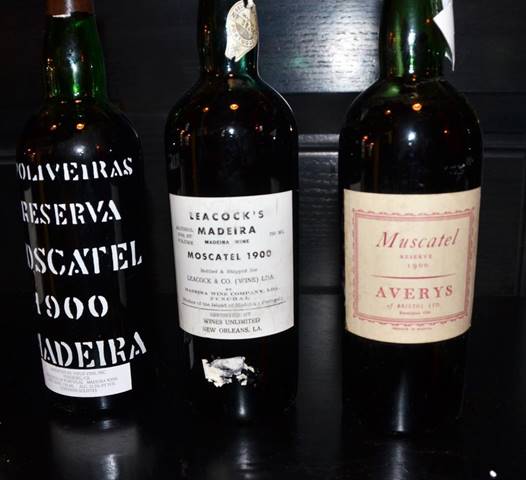
(RH) 1900 Leacock’s Moscatel Frasqueira Madeira – Dark reddish-brown color with golden rim. Medium full, chewy, rich and loaded with dried fruits. It is slightly soft in the acidity department, but it remains a well-made wine in spite of that. Medium in weight, sweet torrefacted flavors of fig, sultana, and salted caramel with a medium long finish. This was produced from Moscatel grapes in Porto Santo, an entirely different island next to the one that people are familiar with. An enjoyable, clean impression of the Moscatel grape. Too bad there wasn’t a bit more acidity to pierce the sweetness and keep this in better balance. 89 points - 4/22/17
(MB) 1900 Leacock Moscatel - Stenciled bottle, with Madeira Wine Company back paper label circa 1980s for export on behalf of Leacock & Co. to Wines Unlimited, New Orleans. The timing is certainly right for this to be ex-D’Oliveira.
(RH) 1900 Avery’s Moscatel Frasqueira Madeira – Super sweet, rich, warm and slightly spirituous, with flavors of dates, figs, prunes and sweet butterscotch. Good acidity and overall balance. Rich and sublimely textured, but not as sweet as a typical Moscatel. There is also some funk and a medium length finish. Overall, an enjoyable Moscatel, but nothing I’d look to buy. 90 points - 4/22/17
(MB) 1900 Avery’s Moscatel - Not stenciled, only a paper label reading Muscatel Reserve 1900. Remains of a plain black wax capsule. This could be from the 1985 MWC purchase of 1900 Moscatel from D’Oliveira, but the capsule appears somewhat older than that. And, while the Leacock cork was firm, the Avery’s cork disintegrated. Possibly from either an earlier MWC purchase or another source.
(RH) 1890 Barros e Sousa Moscatel Frasqueira Madeira – Sold by the wonderful Olim Brothers who we visited on three or four occasions prior to their selling the company to Luis D’Oliveiras next door. It was the best outcome due to the fact they had no heirs to pass the company onto when they both wanted to relax and retire. A well-delineated profile including dried apricot, bees wax, baking spices, marzipan, and lime. This 1890 is concentrated dense, and chewy with a near perfect level of acidity with enough sharpness to really captivate my attention. Bright, yet possessing a somewhat rustic style that was compelling with flavors of unblanched almond, nectarine, ripe figs and golden raisins. Likely in bottle for about 60 years and less overtly sweet. Where do I find more of this beauty? 92 points - 4/22/17
(MB) 1890 Barros e Sousa Moscatel - Founded in 1921, the firm of Artur de Barros e Sousa, Lda. (ABSL) was last run by Artur and Edmundo Olim, fourth-generation descendents of the founders. The ABSL lodge, and all the remaining wine in barrel, were acquired by D’Oliveira—the Olims’ immediate neighbor on the rua dos Ferreiros—in November 2013. While it was around, ABSL was the ultimate artisinal Madeira producer, never formally exporting, instead selling by the bottle to collectors and tourists who visited their lodge. This 1890 Moscatel is of unknown origin and clearly not made by them. Curiously, I own a bottle with very similar stenciling that belonged to Braheem Kassab and bears a BAK embossed wax capsule.
(RH) 1875 D’Oliveiras Moscatel Frasqueira Madeira – A mid-1970’s bottling, this exhibited the darkest colored wine of the day. Dark coffee color. Fragrant stewed prune, mahogany, stewed onions and salted caramel. This is diabetic’s nightmare! Deeply concentrated and flavored with sugar cane, butterscotch, peach preserves and peanut brittle. In possession of nearly sharp acidity which was a good thing as the residual sugar would have made this unpleasant for those that do not like Madeira at this level of sweetness. I’d love to know the grams per liter of this wine. The length of the finish and extraordinary layers of complexity was so much more enjoyable than any other wine in our lineup. Very impressive and I’ve had this D’Oliveiras more than a handful of times before and one time since this note was documented. 95 points ~ 4/22/17
(MB) 1875 D'Oliveira Moscatel - Bottled in the 1960s or 1970s, with a brown wax capsule embossed with initials JPD. The original company, João Pereira D’Oliveira & Filhos, was founded in the 1880s by a São Martinho landowner, João Pereira D'Oliveira. The business expanded in the early 1930s when D'Oliveira’s grandson, Agostinho, married into the Camacho family, adding the resources of the shippers João Joaquim Camacho & Sons and an important 19th-century producer, Julio Augusto Cunha & Sons, founded in 1820. The firm functioned largely as a partadista, supplying other houses, until the 1970s, when, under the name Pereira D’Oliveira Lda., they began exporting.
(RH) 1870 ~ Manuel Jose Vieira ~ Moscatel ~ Frasqueira Madeira – High toned fragrances of menthol, wintergreen, VA and some funky notes and torched brown sugar. I didn’t like it much, yet it was a serviceable bottle that was much drier than I’d like and especially following the D’Oliveiras which was a mistake. Who knew, as I had never even heard of this wine. It’s significant strength was its extra-long sophisticated finish. ~ 88 points ~ 4/22/17
(MB) 1870 Manuel Jose Vieira Moscatel Câmara de Lobos. - Purchased as a 6-bottle lot at Christie’s New York, December, 2014. Provenance: Agostinho Pereira Gouveia of Lisbon. (A further 12 bottles, with different provenance, were offered at Christie’s London, March 2017.) As noted above, Manuel Jose Vieira owned the now-famous Ribeiro Real vineyards at Câmara de Lobos, and, according to Ricardo Freitas, won a gold medal for his wines in Paris in 1889. In addition to the Câmara do Lobos vineyards, Vieira owned substantial vineyards at São Martinho.
Despite what the label says, Ricardo is certain that this wine would have come from the area near today’s Quinta da Bela Vista hotel in São Martinho.
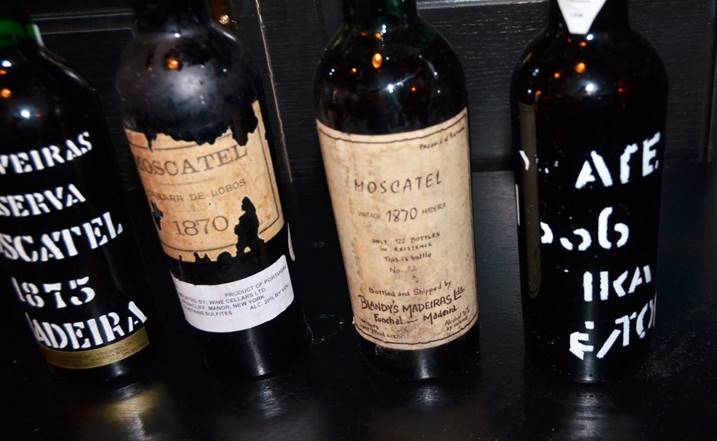
(RH) 1870 Blandy’s Moscatel Frasqueira Madeira – Crazy dark color with a prominent golden green edge. Great aromatics, with coconut, ripe pineapple, almond paste and crème caramel. Maybe the sweetest of the Moscatels we tried, but the D’Olly was a strong rival in that regard. Cutting edge precision with the acidity here, it kept everything in balance and it handled the citrusy lime, ripe melon and papaya flavors along with candied pralines. Deeply concentrated and sublimely textured, leading to a ripe and uber-sweet and persistent aftertaste. 92 points - 4/22/17
(MB) 1870 Blandy’s Moscatel - Front and back paper Blandy’s labels that are differentfrom those of the Blandy’s Madeiras sold by Sherry-Lehman in the 1960s. The back label is signed by Ferdinando de Bianchi, who became MWA managing director in 1969. (See note for 1875 Blandy’s Bastardo.) According to the back label, the wine came from “a collection of fine vintages originally belonging to a Madeira family by the name of Manuel Valentino Pinto.” There were 120 bottles, of which this bottle is number 32.
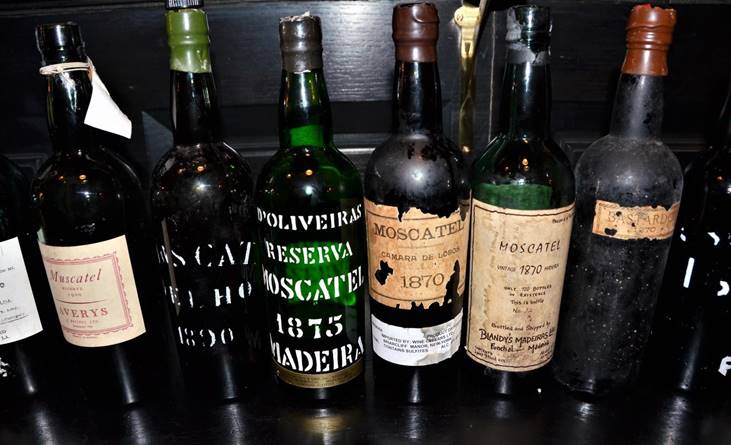
(RH) 1856 Barbeito Moscatel Frasqueira Madeira – We were hoping to finish off the tasting on a high note and this definitely did the trick! Stunning notes of vanilla extract, roasted nuts, lemon zest, saline and mahogany. Not that sweet, the driest profile of all 8 Moscatels. Possibly the MJV 1870 was as dry, but that was the only close to this 1856. Great balance and complex from stem to stern and with excellent length. 94 points - 4/22/17
(MB) 1856 Barbeito Family Moscatel – Bottled from magnum in 2002. One of thirteen wines, ranging in vintage from 1802 to 1856, that Mario Barbeito de Vasconcelos hand-picked in 1974 as his legacy for his granddaughter Isabel who was emigrating to Brazil. The wines were kept in the family cellar in Funchal, awaiting either her return or a time when she would ask that they be sent to South America. Sadly, Isabel passed away before she could be reunited with the wines. Purchased from the family by The Rare Wine Co. in 2002.
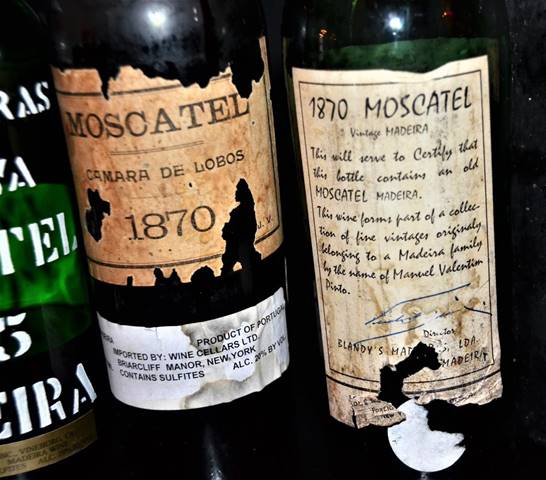

Fantastic review I envy you for this rare experience.